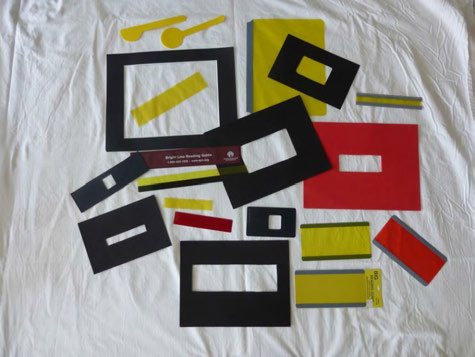“Higher functioning students with CVI find it useful to track pictures, shapes, numbers, letters, and words with their fingers. It is important that they do not lift their fingers from the paper but slide their fingers from target to target. Sliding their fingers helps them to manage the “crowding phenomenon.” The use of folded papers and paper markers may also reduce that visual stimulai that are present at one time.”
 photo retrieved http://strategytosee.com/
photo retrieved http://strategytosee.com/
 APH Bright Line Reading Guide click here
APH Bright Line Reading Guide click here
“Experimental data have suggested that the use of color as a stimulus with forms facilitates the perception of forms by patients with CVI (Merrill & Kewman, 1986). Therefore, when one teaches simple shapes and letters, it may be helpful to outline them with color, making sure that the contrast between them and their background is high. Yellow and sometimes red are thought to be more easily perceived. Initially, the identification of objects can be aided by keeping the color of common objects constant until the concept has been established to some degree; later, other colors may be added. For those who have enough visual function to deal with picture books, stories with a single, simple picture on a page will be more useful than is more crowded material. Pastel colors may be painted over with acrylic paint in primary colors and unnecessary details may be eliminated. A number of commercially available books may be adapted in this way for use with children with mild CVI. The color coding of words or letters with lines or dots is particularly beneficial for helping higher functioning children with CVI to keep their place or to indicate where their response should go.”
Groenveld, M., Jan, J., & Leader, P. (1990). Observations on the habilitation of children with cortical visual impairment. Journal of Visual Impairment and Blindness, 84(1), 11-15.
Resources to try:
CVI SCOTLAND click here
Bookshare
Bookshare® is an ebook library that makes reading easier. People with reading barriers can customize their experience and read in ways that work for them. See how it works!
A person who is blind or has low vision and who is unable to read standard print qualifies for Bookshare as long as a competent authority confirms that the person is legally blind or has a significant problem accessing text.
Examples of Competent Authorities:
- teacher of the visually impaired
- special education teacher
- family doctor
- ophthalmologist
- optometrist
- National Library Service for the Blind and Physically Handicapped, or similar government body outside the U.S.
Voicedream Reader
http://www.voicedream.com/reader/
http://www.readright.ucl.ac.uk/index.php
“A child with CVI often needs a print size far larger than the size they can “see”, in order to read effectively. Providing that the largest font size is big enough, E readers such as a Nook Glowlight or Kindle can make a big difference and as they are ‘mainstream’ popular technology children are generally keen to use them. Some children may need extra spacing between lines and even spacing between letters to be able to read. Again a laptop or computer onto which work can be typed or downloaded as an electronic file and then adapted, makes this possible. These strategies can make the difference between a child learning to read or not at all in some cases.”
http://www.cvisociety.org.uk/#!strategies/c17j7
Also check out: https://cvi.aphtech.org/?page_id=508 strategy page

